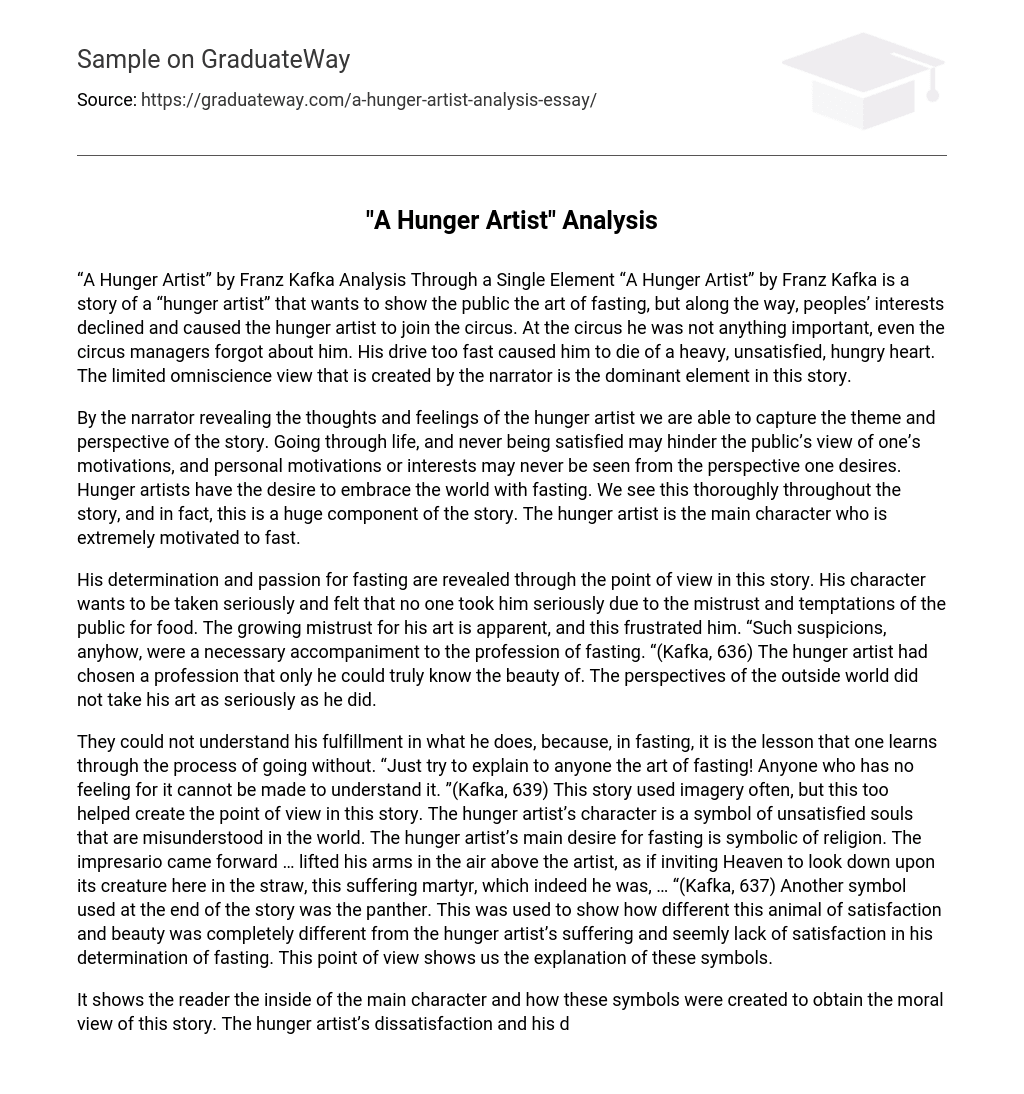“A Hunger Artist” by Franz Kafka Analysis Through a Single Element “A Hunger Artist” by Franz Kafka is a story of a “hunger artist” that wants to show the public the art of fasting, but along the way, peoples’ interests declined and caused the hunger artist to join the circus. At the circus he was not anything important, even the circus managers forgot about him. His drive too fast caused him to die of a heavy, unsatisfied, hungry heart. The limited omniscience view that is created by the narrator is the dominant element in this story.
By the narrator revealing the thoughts and feelings of the hunger artist we are able to capture the theme and perspective of the story. Going through life, and never being satisfied may hinder the public’s view of one’s motivations, and personal motivations or interests may never be seen from the perspective one desires. Hunger artists have the desire to embrace the world with fasting. We see this thoroughly throughout the story, and in fact, this is a huge component of the story. The hunger artist is the main character who is extremely motivated to fast.
His determination and passion for fasting are revealed through the point of view in this story. His character wants to be taken seriously and felt that no one took him seriously due to the mistrust and temptations of the public for food. The growing mistrust for his art is apparent, and this frustrated him. “Such suspicions, anyhow, were a necessary accompaniment to the profession of fasting. “(Kafka, 636) The hunger artist had chosen a profession that only he could truly know the beauty of. The perspectives of the outside world did not take his art as seriously as he did.
They could not understand his fulfillment in what he does, because, in fasting, it is the lesson that one learns through the process of going without. “Just try to explain to anyone the art of fasting! Anyone who has no feeling for it cannot be made to understand it. ”(Kafka, 639) This story used imagery often, but this too helped create the point of view in this story. The hunger artist’s character is a symbol of unsatisfied souls that are misunderstood in the world. The hunger artist’s main desire for fasting is symbolic of religion. The impresario came forward … lifted his arms in the air above the artist, as if inviting Heaven to look down upon its creature here in the straw, this suffering martyr, which indeed he was, … “(Kafka, 637) Another symbol used at the end of the story was the panther. This was used to show how different this animal of satisfaction and beauty was completely different from the hunger artist’s suffering and seemly lack of satisfaction in his determination of fasting. This point of view shows us the explanation of these symbols.
It shows the reader the inside of the main character and how these symbols were created to obtain the moral view of this story. The hunger artist’s dissatisfaction and his drive to suffer caused the conflict in this story. As previously said, the world just could not understand his infatuation with fasting. His dissatisfaction and longing to fast caused him to place himself in the circus. People overlooked him and wanted to see more exciting events than a man suffering in a cage. The point of view shows us his determination and mindset that created the conflict. A mind can push a man, and push a man far. If he is not careful, this will be his downfall. ” (Yslo, 25) The hunger man’s unsatisfied conflict within himself caused him to never see his potential or be admired for his determination by the public. “… that was in its way the stupidest lie ever invented by indifference and inborn malice since it was not the hunger artist who was cheating; he was working honestly, but the world was cheating him of his reward. ”(Kafka, 640) The hunger artist’s cage is understood in the story by the point of view.
To the main character, this was a place he called home. This is where he felt safe. But contrary to the way the character expressed the feelings of his cage, the cage has isolated him and closed him off from the world. This is where he is comfortable but never understood. The straw at the bottom of the cage creates the character as an animal on display when we know as the reader, he was not under the impression he was viewed as such. The outside world, looking in, sees a man locked in his own discomfort and suffering.
All of these elements of “The Hunger Artist” rely on the narrator’s limited omniscience point of view. This point of view showed us the raw perspectives of the main character; therefore, we could understand where he was coming from. As an outsider looking in, we can easily understand why it was so hard for the world to grasp his perspectives. The narrator gave an impeccable story through the character. He showed us how important it is to be satisfied, which leads to a better public understanding of yourself. Again, Kafka’s point of view can enlighten many people.
Going through life, and never being satisfied may hinder the public’s view of one’s motivations, and personal motivations or interests may never be seen from the perspective one desires. The author’s story was captured beautifully, and she strongly focused in on the view of self and the view of the world of one’s self.
Works Cited
- Kafka, Franz. “A Hunger Artist. ” Analyzing Short Stories. 7 Ed. Joseph Lostracco and George Wilkerson. Iowa: Kendal/Hunt Publishing Co. , 2008. 635-41. Print.
- Yslo, Marion. “Confessions of the Mind. ” Kronos Reviews. N. p. , 22 Dec. 2006. Web. 5 Mar. 2010.





